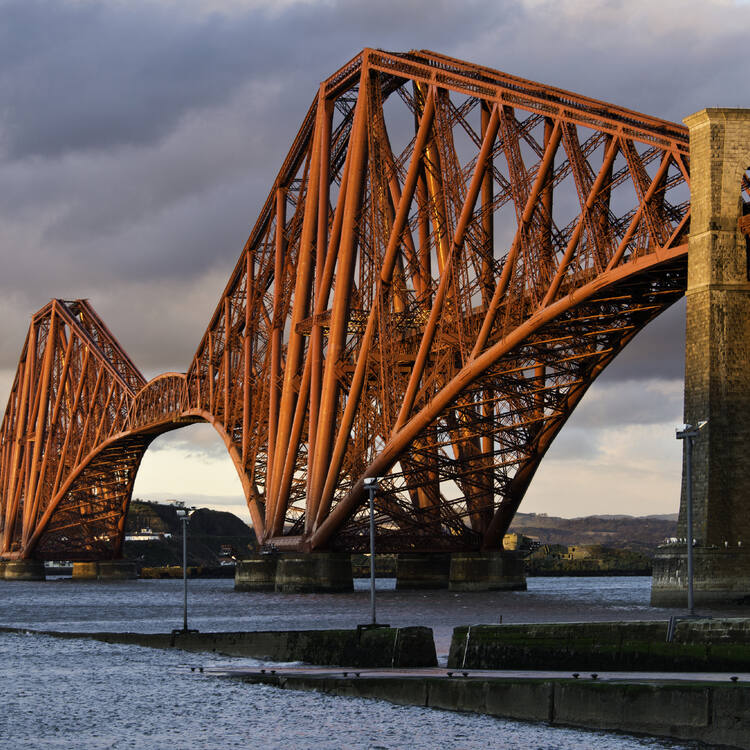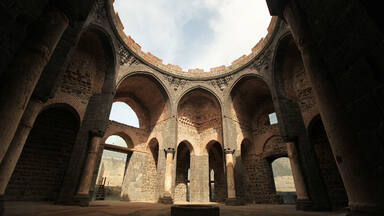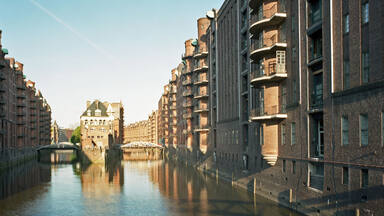The Forth Bridge
The Forth Bridge
This railway bridge, crossing the Forth estuary in Scotland, had the world’s longest spans (541 m) when it opened in 1890. It remains one of the greatest cantilever trussed bridges and continues to carry passengers and freight. Its distinctive industrial aesthetic is the result of a forthright and unadorned display of its structural components. Innovative in style, materials and scale, the Forth Bridge marks an important milestone in bridge design and construction during the period when railways came to dominate long-distance land travel.
Description is available under license CC-BY-SA IGO 3.0
Le pont du Forth
Le pont ferroviaire, qui enjambe l’estuaire du fleuve Forth en Ecosse avait, quand il fut inauguré en 1890, les travées les plus longues du monde (541m). Le pont demeure l’un des plus grands ponts cantilever au monde et il fonctionne encore quotidiennement, permettant le transport de passagers et de marchandises. Son esthétique industrielle caractéristique résulte de la présentation, franche et dépouillée, de ses éléments structurels. Le pont du Forth, novateur dans son style, ses matériaux et son envergure, marque un jalon important dans la conception et la construction des ponts durant la période au cours de laquelle les lignes de chemins de fer se sont imposées dans les voyages longue distance par voie terrestre.
Description is available under license CC-BY-SA IGO 3.0
جسر فورث
يُعد جسر السكك الحديدية هذا، الذي يمر فوق مصب نهر فورث باسكتلندا، أطول جسر كابولي متعدد الفتحات في العالم. ودشِّن الجسر في عام 1890 ولا يزال يُستخدم حتى اليوم لنقل الركاب والبضائع. ويستمد الجسر شكله "الصناعي" المميز من هيكله الذي تظهر عناصره الحديدية بطابعها المجرد. ويُعتبر جسر فورث الطليعي بنمطه المعماري ومواد بنائه وحجمه مثالاً مهماً على طريقة تصميم الجسور وبنائها في مرحلة كانت شبكة السكك الحديدية قد اكتسبت فيها أهمية كبرى في الأسفار البرية الطويلة.
source: UNESCO/CPE
Description is available under license CC-BY-SA IGO 3.0
弗斯桥
这座横跨苏格兰福斯河口三角湾的铁路桥是世界上最长的多跨度悬臂桥。这座桥1890年开通,一直是客货运主干道。各种未经装饰的建筑结构元素的直接呈现构成了它独具特点的工业设计美学。在风格、材料和规模上的创新使弗斯桥成为以铁路为陆路长途运输主要交通方式时代桥梁建设与设计的重要里程碑。
source: UNESCO/CPE
Description is available under license CC-BY-SA IGO 3.0
Мост Форт-Бридж
Железнодорожный мост Форт-Бридж, пересекающий эстуарий реки Форт в Шотландии, является самым длинным в мире консольным мостом с несколькими пролетами. По мосту, открытому в 1890 году, до сих пор ходят пассажирские и товарные поезда. Выполненный в характерном индустриальном стиле, мост отличается строгостью дизайна и четкостью линий его структурных элементов. Новаторский по стилю, используемым материалам и масштабу, Форт-Бридж представляет важный этап в проектировании и строительстве мостов в эпоху, когда железные дороги стали доминировать в наземных дальних перевозках.
source: UNESCO/CPE
Description is available under license CC-BY-SA IGO 3.0
Puente sobre el río Forth
Tendido en Escocia sobre el estuario del río Forth, este puente en ménsula de arcadas múltiples es el más largo del mundo en su género. Se abrió al tráfico ferroviario en 1890 y todavía se sigue utilizando actualmente para el transporte de pasajeros y mercancías por tren. Su estética industrial característica es el resultado de la sencillez y pureza de sus componentes estructurales. El diseño y la construcción de este puente, innovador por sus materiales, su estilo y su envergadura, marcaron un hito importante en la época en el que el ferrocarril se impuso como medio de transporte terrestre de viajeros y mercancías a largas distancias.
source: UNESCO/CPE
Description is available under license CC-BY-SA IGO 3.0
フォース橋
スコットランド東部のフォース川河口に架かる長さ2529mのフォース橋は、世界で最初に複数のカンチレバー(片持ち梁)を採用したトラス橋。1880年代には新しい材料だった軟鋼を大量に使用し、最先端の土木工学の設計原理と工法によって建設された橋は革新的で、世界の工学分野の奇跡ともいわれた。外観は装飾を施さず、大量の構造材をそのまま見せる簡素なものである。鉄道が長距離内陸輸送の主役となった時代の橋梁設計と建設技術の発展を示すこの橋は、1890年の開通以来、現在も使用され続けている。source: NFUAJ
De Forth brug
Deze spoorbrug over de monding van de Forth rivier in Schotland is de langste cantileverbrug met meerdere steunpunten ter wereld. De brug opende in 1890 en is nog steeds operationeel. De brug heeft een bijzonder industrieel voorkomen door de zichtbaarheid van de afzonderlijke onderdelen van de structuur. De brug is innovatief in stijl, materiaal en schaal. Daardoor is de brug een belangrijke mijlpaal in het ontwerp en de bouw van bruggen in de tijd waarin de spoorwegen het vervoer over land voor lange afstanden begonnen te domineren.
Source: unesco.nl
Outstanding Universal Value
Brief synthesis
The Forth Bridge, which spans the estuary (Firth) of the River Forth in eastern Scotland to link Fife to Edinburgh by railway, was the world’s earliest great multispan cantilever bridge, and at 2,529 m remains one of the longest. It opened in 1890 and continues to operate as an important passenger and freight rail bridge. This enormous structure, with its distinctive industrial aesthetic and striking red colour, was conceived and built using advanced civil engineering design principles and construction methods. Innovative in design, materials, and scale, the Forth Bridge is an extraordinary and impressive milestone in bridge design and construction during the period when railways came to dominate long-distance land travel.
This large-scale engineering work’s appearance is the result of a forthright, unadorned display of its structural elements. It is comprised of about 54,000 tons of mild steel plate rolled and riveted into 4m diameter tubes used in compression, and lighter steel spans used in tension. The use of mild steel, a relatively new material in the 1880s, on such a large-scale project was innovative, and helped to bolster its reputation. The superstructure of the bridge takes the form of three double-cantilever towers rising 110 m above their granite pier foundations, with cantilever arms to each side. The cantilever arms each project 207 m from the towers and are linked together by two suspended spans, each 107 m long. The resulting 521-m spans formed by the three towers were individually the longest in the world for 28 years, and remain collectively the longest in a multi-span cantilever bridge. The Forth Bridge is the culmination of its typology, scarcely repeated but widely admired as an engineering wonder of the world.
Criterion (i): The Forth Bridge is a masterpiece of creative genius because of its distinctive industrial aesthetic, which is the result of a forthright, unadorned display of its massive, functional structural elements.
Criterion (iv): The Forth Bridge is an extraordinary and impressive milestone in the evolution of bridge design and construction during the period when railways came to dominate long-distance land travel, innovative in its concept, its use of mild steel, and its enormous scale.
Integrity
The property contains all the elements necessary to express the Outstanding Universal Value of The Forth Bridge, including granite piers and steel superstructure. The 7.5-ha property is of adequate size to ensure the complete representation of the features and processes that convey the property’s significance, and it does not suffer from adverse effects of development or neglect.
Authenticity
The Forth Bridge is fully authentic in form and design, which are virtually unaltered; materials and substance, which have undergone only minimal changes; and use and function, which have continued as originally intended. The links between the Outstanding Universal Value of the bridge and its attributes are therefore truthfully expressed, and the attributes fully convey the value of the property.
Protection and management requirements
The Forth Bridge is listed at Category ‘A’ as a building of special architectural or historic interest, giving the property the highest level of statutory protection. Its immediate surroundings are also protected by means of a suite of cultural and natural heritage designations. Owned by Network Rail Limited, the property will be managed in accordance with a Property Management Plan by the bodies that have a statutory planning function. The Forth Bridges Forum partnership has been established to ensure that local stakeholders’ interests remain at the core of the management of the Forth bridges.
Specific long-term expectations related to key issues include maintenance of strong community support, broadening understanding in the context of world bridges, attention to developments within key views, risk management, and inspiring others.


